Dalmatian Dogs - They're Easy To Spot!
Dalmatian dogs are one of the most distinctive and easily recognized breeds, thanks to their unique spotted coat. But there's more to these dogs than just their looks. Dalmatians have been part of human history for centuries, and they bring with them a wealth of characteristics that make them a fascinating breed. Let's take a deeper dive into all things Dalmatian
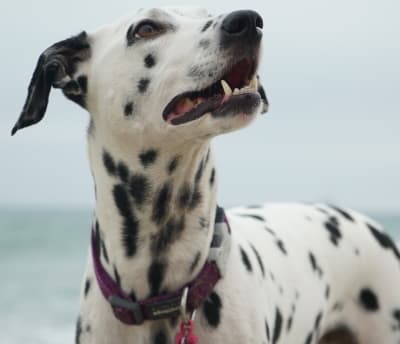 Courtesy C.Heath
Courtesy C.HeathA Brief History of the Dalmatian
Dalmatians are an
ancient breed, with a history that is as spotty as their coats! While their
exact origin remains unclear, many believe they originated in the region of
Dalmatia, modern-day Croatia, which is how they got their name. Artifacts
dating back as far as 2000 BC depict spotted dogs that resemble today’s
Dalmatians, suggesting the breed’s long-standing connection with humans.
Historically, Dalmatians have had a variety of jobs—protecting carriages, acting as sentinel dogs for traveling gypsies, and even running alongside horse-drawn fire engines in the 1800s.
Their stamina, strength, and natural rapport with horses made them ideal for these roles. It was also during this time that Dalmatians became synonymous with firehouses, where they cleared the way for fire engines and provided comfort and protection to firefighters.
The Dalmation was recognized by the American Kennel Club (AKC) in 1888 and is part of the non-sporting group.
In the modern world, hardly anyone would be unfamiliar with the unique black and white (or brown and white) appearance of Dalmatian dogs, if only from having seen many of them in the well-promoted Disney movie - 101 Dalmatians.
Characteristics
Dalmatians, aka Dals, are known for their high energy and intelligence. They’re affectionate dogs that love to be part of family activities. However, their strong personalities can sometimes lead to challenges for new owners.
Dalmatians are people-oriented dogs and thrive on attention and companionship. They form strong bonds with their families and enjoy being involved in every aspect of family life. However, they do not like being left alone for long periods and will become sad and anxious if isolated or ignored.
Lively and playful, these dogs are incredibly energetic and require lots of mental and physical stimulation.
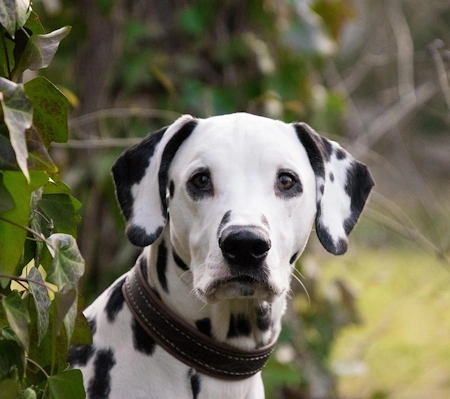
Physical Appearance
The Dalmatian is instantly recognizable by its striking white coat adorned with black or liver-brown spots.
Weight: 50 to 55 pounds
Height: Ranges between 19 to 23 inches
The basic coat color of pure white is marked with evenly distributed
distinct spots of black or liver-brown that vary in size. Puppies are born white, without spots, which start to appear a few weeks later.
Only the two colors of spots, mentioned above, are recognized by the AKC breed standard.
The Dal has a strong muscular body with sturdy straight legs and an overall symmetrical appearance. The tail is inline with the body and has a slight upward curve.
The
feet are round and compact with thick, elastic pads and well arched toes.
The ears are set close to the head, have a thin and fine texture and are of average size.
The medium sized eyes are set slightly spaced apart and convey an alert and intelligent expression. They may be brown or blue, or a combination of both; usually darker in black-spotted than in liver-spotted dogs.
The lips are close fitting and the teeth meet in a scissors bite.
Grooming Dalmatian Dogs
Dalmatian dogs have a smooth coat that is short and fine yet dense and lies
close to the body. The coat should have a sleek, glossy and healthy
appearance.
Although this breed is considered to be very clean and pretty much
without odor, it does shed a lot year round, and even more so during its
seasonal shedding times.
Here's what you'll
need to do to keep hair from piling up everywhere around the house while keeping your Dalmatian looking and feeling great:
Brushing: Regular brushing at least three to four times a week, with a curry comb, and frequent use of a de-shedding tool to handle the ongoing shedding and keep the Dal's coat shiny.
Ear
Care: Due to their predisposition to deafness, regular weekly ear
cleaning is essential, unless your vet advises otherwise.
Check their ears for signs
of redness, odors, pain or wax buildup. If any of these are present, especially inflammation, consult with your vet before attempting to clean them.
Bathing:
Dalmatian dogs are naturally clean, so they don’t need frequent baths, in fact too often can cause skin issues.
However, they may need a bath after outdoor adventures or exposure to dirt and
mud. Freshening up the coat with dog wipes is handy and nice for everyone!
Nail clipping: should be done routinely, or when you
can hear the sound of their nails as they walk across the floor.
Overgrown nails can cause problems, so get 'em cut.
If you or your Dal are a bit nervous about nail clipping, you can use a dremel instead of clippers, which will be a much easier experience for both of you.
While you're working on the feet, give the paws a thorough inspection for embedded objects such as foxtails, cuts, cracks, or infections. Foxtails are especially dangerous and can work their way into the legs of the pet - I know from experience!
Dental Hygiene:
Brushing your dog's teeth is just as important as every other part of
his care - in some ways, more so. Healthy gums and clean teeth, prevent
infections and contribute to a longer life according veterinarians. Plus
you will be sparing your pet from painful toothaches.
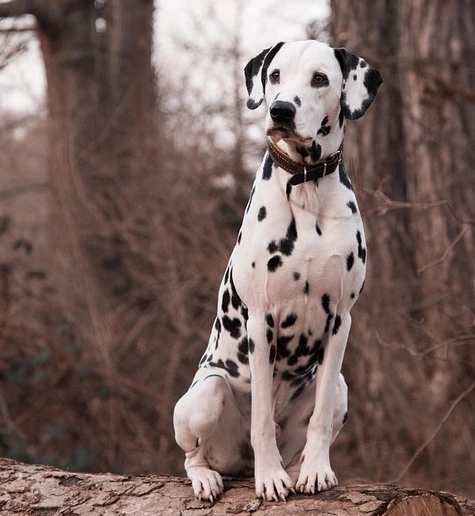
Personality and Temperament
Dalmatians are great companions for active families who enjoy outdoor activities. Whether it's running, hiking, or playing fetch, your Dalmatian will always be ready to join in the fun.
Trainability: Dalmatians are smart and eager to please, but they can also be a bit stubborn. They are known for their incredible retentive memory which is a big plus in training them.
They respond well to positive reinforcement and consistency in training. Early socialization is key to raising a well-behaved Dalmatian beginning with puppy training classes. With the right training, they can excel in dog sports and agility courses.
Dalmatians need a confident owner who can establish themselves as the pack leader. Without consistent leadership, Dalmatians will take charge and display dominant behavior. However, with firm yet gentle guidance, they can be loyal, well-behaved companions.
Early socialization is highly recommended along with on-going training for this breed because of their protective instincts. Expose them to other people,
plus a variety of experiences, places and situations, as well as other canines.
When it comes to house training, the Dalmatian usually gets the
hang of this very quickly because of his intelligence as well as his
natural desire to be clean.
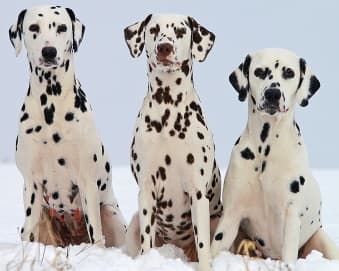 Courtesy A.Skeeze
Courtesy A.SkeezeDalmatian Health
Finding a reliable vet to evaluate their health before you acquire one, is a very important so you know what issues to look out for.
Like all breeds, Dalmatians are prone to certain health conditions. Being aware of these risks will help you provide the best care for your Dalmatian.
Deafness is a common inherited condition in this breed because
they lack a particular enzyme related to hearing, but they still can
make marvelous pets and be trained very well - perhaps with a
little help from a specialist at the beginning.
Approximately 8% of Dalmatians are born completely deaf, and an even larger percentage may have partial hearing loss. If you adopt a Dalmatian with deafness, specialized training techniques can be used to communicate effectively.
Responsible breeders will have had the parents tested and will have entire litters tested to be certain that all can hear. The BAER test is the standard for determining hearing status.
Bladder Stones: Dalmatians carry a gene for an inherited condition called
hyperuricosuria (HU), in which uric acid levels in the urine are
particularly high making them much more likely to develop bladder
stones. There is a
DNA test, that breeders can use, to detect the genetic mutation before breeding, and for customers to ask about before buying a Dalmatian.
To help prevent this condition, it’s important to keep
your Dalmatian well-hydrated, provide a special diet as directed by your vet, and ensure they get
frequent walks.
Hip Dysplasia: A genetic joint disease that results from the malformation of the hips and is characterized by joint weakness, stiffness, and pain.
As with many larger breeds,
Dalmatians can be prone to this condition.
Regular vet checkups and maintaining a healthy
weight can help minimize this risk. Joint health supplements may also be recommended.
Skin Allergies: Additionally, Dalmatians are susceptible to different types of dermatitis and other skin allergies from pollens and grasses. These are partly genetic in nature, but can also be environmental. Medications can be helpful for these conditions, so pet parents are advised to monitor their Dal's coat and skin condition regularly.
With the benefit of the appropriate high quality diet, sufficient exercise and regular visits with a veterinarian, pet parents can expect to enjoy their Dal for up to 13 years.
Those interested in the Dalmatian are advised
to avoid inexperienced back yard breeders and seek referrals to professional breeders (shown end of page) who strive to perpetuate healthy puppies and desirable traits in the
breed.
For more detailed health information visit Dalmatian Club of America Foundation.
How Active Is This Breed?
A very energetic breed with almost unlimited stamina. They need both mental and physical exercise and love to play games.
Daily long walks are a must. They also make great partners for those who
enjoy distance running - providing they are gradually conditioned to
the duration.
Be aware that a Dal's
bones and joints aren't at their mature strength until
two years of age, so avoid overly vigorous or demanding exercise before then.
Swimming is another excellent activity suited to the
breed and has the advantage of being low impact.
When families are time-challenged or weather inclement, a dog treadmill is a handy exercise alternative.
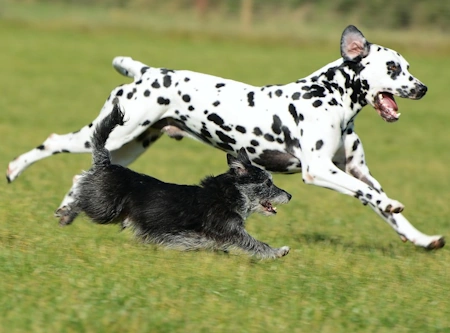
Ideal Living Space
The ideal situation is a house with a large, securely fenced yard where they can spend time playing - preferably with you in the game. If the space allows the setup of an agility course that would be a perfect activity for the Dal's high energy and fun.
Make sure the indoor space is free of toxic plants, loose cords, or anything that may be unsafe for the inquiring mind of a Dal to investigate. Provide puzzle toys and other fun games to engage him mentally instead.
They can adapt to either apartment or condo living accommodations providing sufficient exercise is provided.
Getting Along With Children?
Dalmatians are very affectionate dogs and are generally good with young children, but early socialization and training is crucial, to help them establish good behavior.
Best suited to families with young adult children who are more mature in their understanding of pets and have had good relationships with them.
While the Dal is playful and loves to have fun, he is a large dog, and that combined with his lively high energy, would not be the ideal breed to be around toddlers.
As with any breed, it is always the recommended policy to have an adult supervise interactions between children and pets.
Companion For Seniors?
While Dalmatian dogs are affectionate and love companionship, they require extensive training, exercise and grooming which would not be the ideal for seniors or more sedentary
families.
However, they are very protective and do make good watch dogs for those living alone.
Is a Dalmatian Right for You?
Dalmatians are not for everyone. They are high-energy, strong-willed, and require a committed, active family to meet their exercise and emotional needs.
However, for those who are ready to provide the care, training, and attention they require, Dalmatians can be incredibly rewarding companions.
Their playful, loving nature makes them great family dogs—just be prepared for their boundless energy and occasional stubbornness!
Finding A Dalmatian
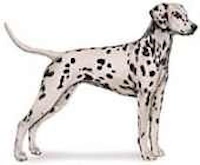
If you are looking for a purebred with a pedigree, find a professional breeder and prepare a list of questions to ask about their breeding program.
You'll especially want to know about the tests that have been completed on their breeding stock including BAER for congenital deafness; OFA evaluation for hip dysplasia, and any elective tests recommended by the Dalmation Club Of America.
Be sure to ask how they select the sire and dam and what steps they take to ensure healthy litters and begin socialization prior to sale of puppies.
After
reading this page, you'll be ready to meet with a
breeder to ask these questions before considering a purchase. A dedicated responsible breeder will also have a lot of questions for you to determine your commitment and experience in raising a Dal or other breeds.
Here's where to find information and listings of reputable breeders:
- The American Kennel Club maintains a list of breeders pledged to uphold AKC-endorsed responsible breeding practices: https://marketplace.akc.org/
- Reputable
breeders can be found through lists on the American Kennel Club’s
website.
Available puppies
can also be found in the AKC marketplace: https://marketplace.akc.org/.
- For rescues, and breeder referrals: https://dalmatianclubofamerica.org/find-a-dalmatian/ which is the official club for Dalmation dogs.
Your local breed club and/or your local animal shelter are other sources to check for rescues and adoptable Dals.
The cost of a puppy is between
$500 to $1,200, but remember to calculate the many additional expenses such as dog
license, vaccinations, insurance, food, bedding, dog crate etc. Good luck.
Before You Go...
If you like the content of this page, as well as others on my site, please give it some love by clicking on the heart in the lower right hand corner. This helps me keep providing enjoyable and useful content.
Thank you.
Book Recommendation
This guide, for those interested in acquiring a Dalmatian, presents a realistic portrayal of this purebred dog, whose energy and training demands are far beyond the scope and ability of most first-time owners. Due to the popularity of the famous Disney films, Dalmatians have long been the most likely "impulse buy" in the dog world, which has led to many Dalmatians being abandoned in shelters.
Share Your Thoughts on
Dalmatians!
Do you have a Dalmatian? Or perhaps you’ve been thinking about adding one to your family? Share your experiences with us! We’d love to hear from Dalmatian owners about what it’s like living with this amazing breed.
We invite any and all dog lovers to make a post about this breed, or their favorite breed and we'll publish your
comments on a webpage for others to enjoy. We'll even add your name if you'd like the recognition.
Visit this page where you'll find a
text box to post your comments. You'll also be able to read stories that others have written about their favorite
dogs.
Go on, give it a try!
- Home ›
- AKC Breeds ›
- Non-Sporting Dogs ›
- Dalmatian

 Dalmation Guide
Dalmation Guide